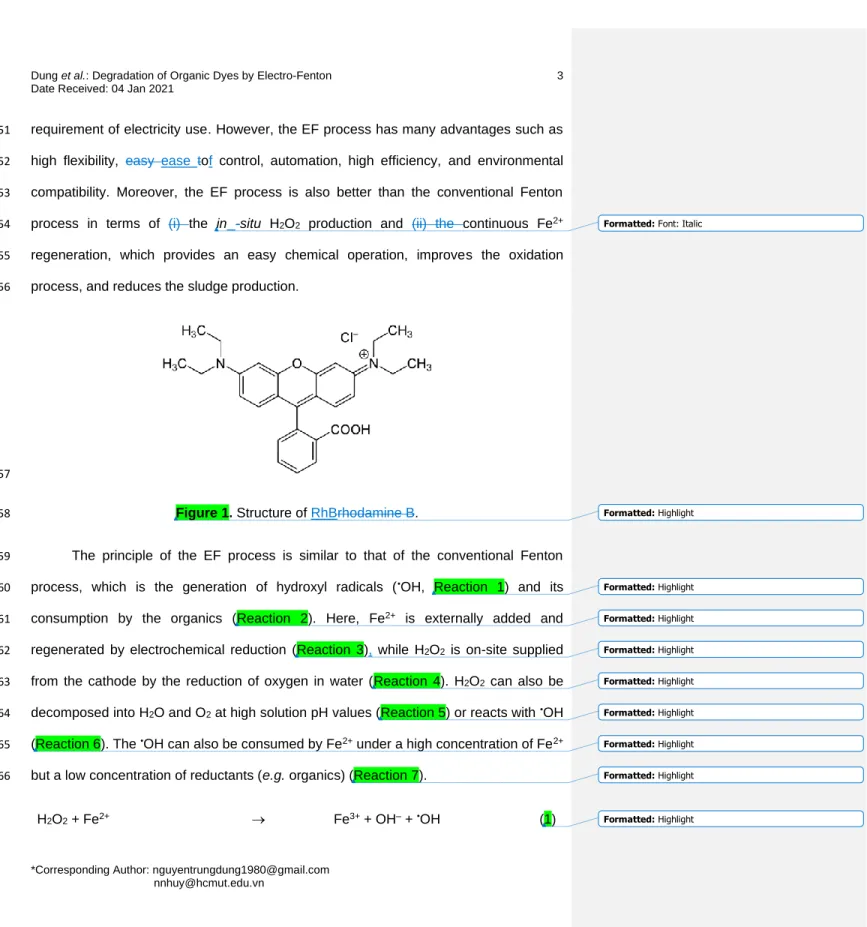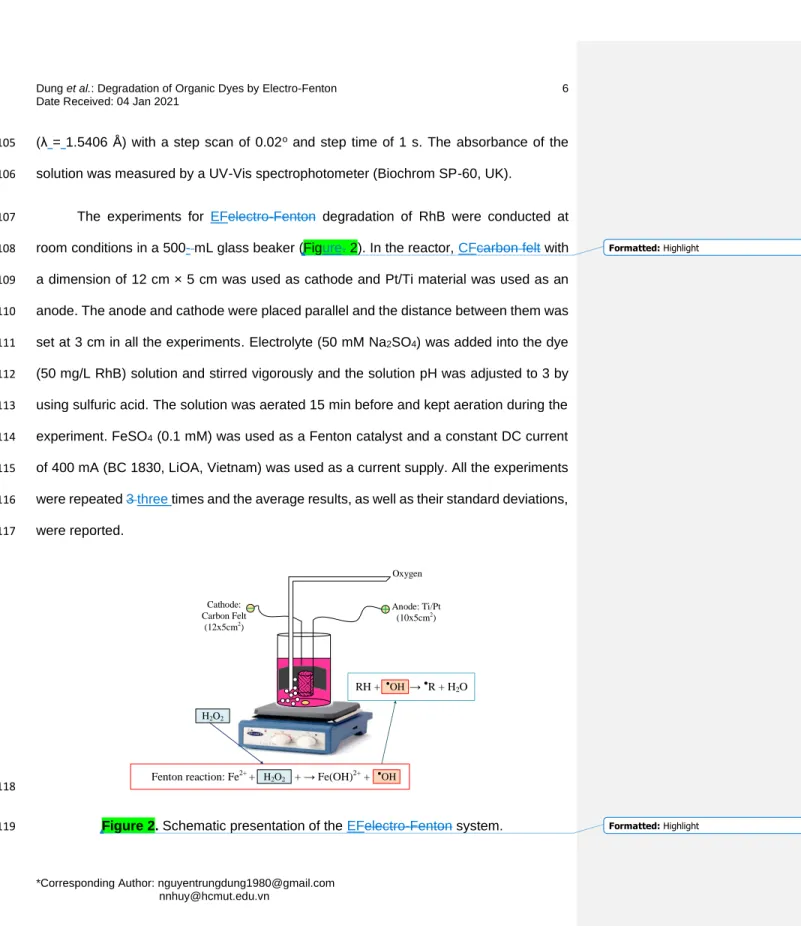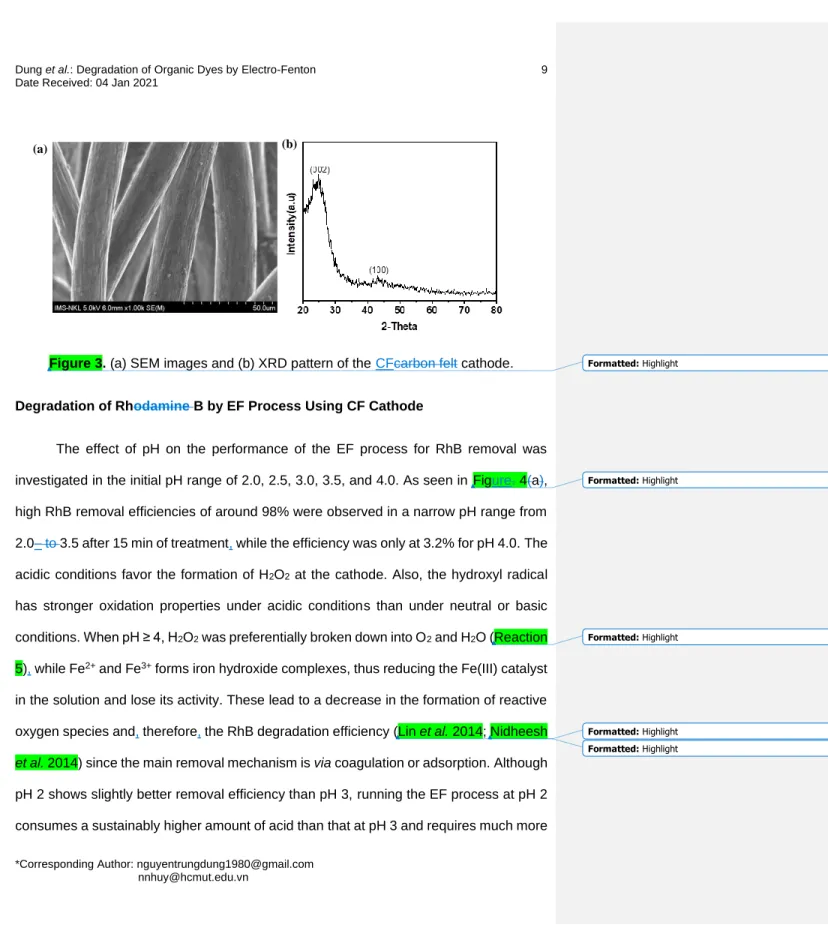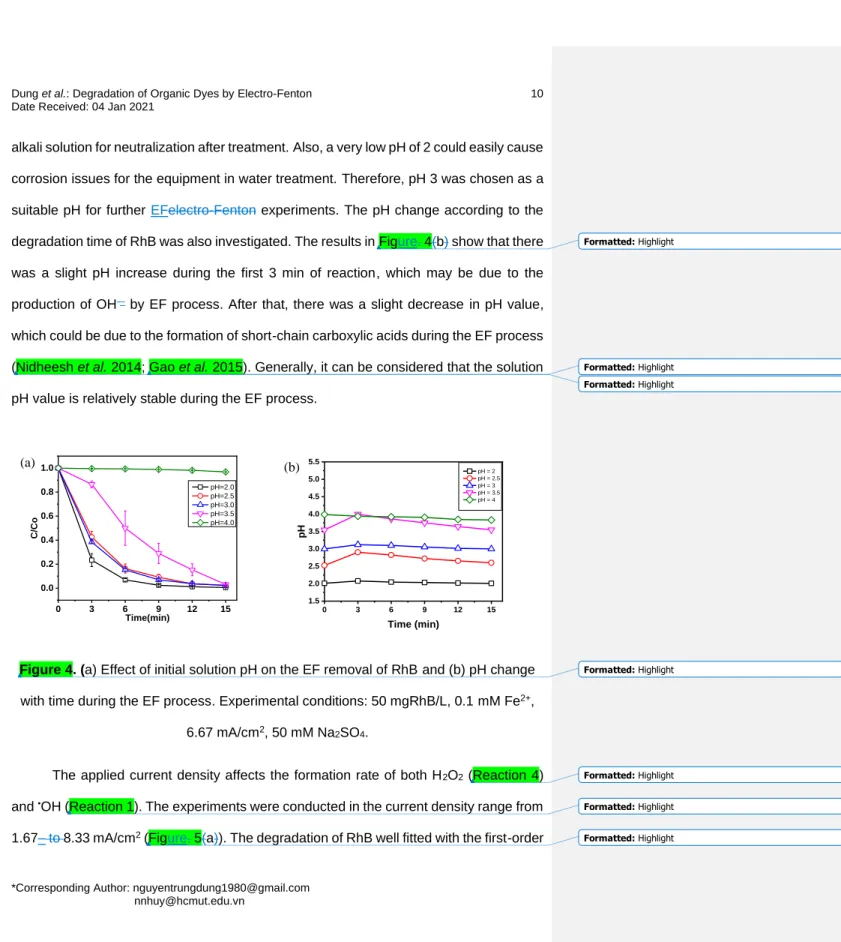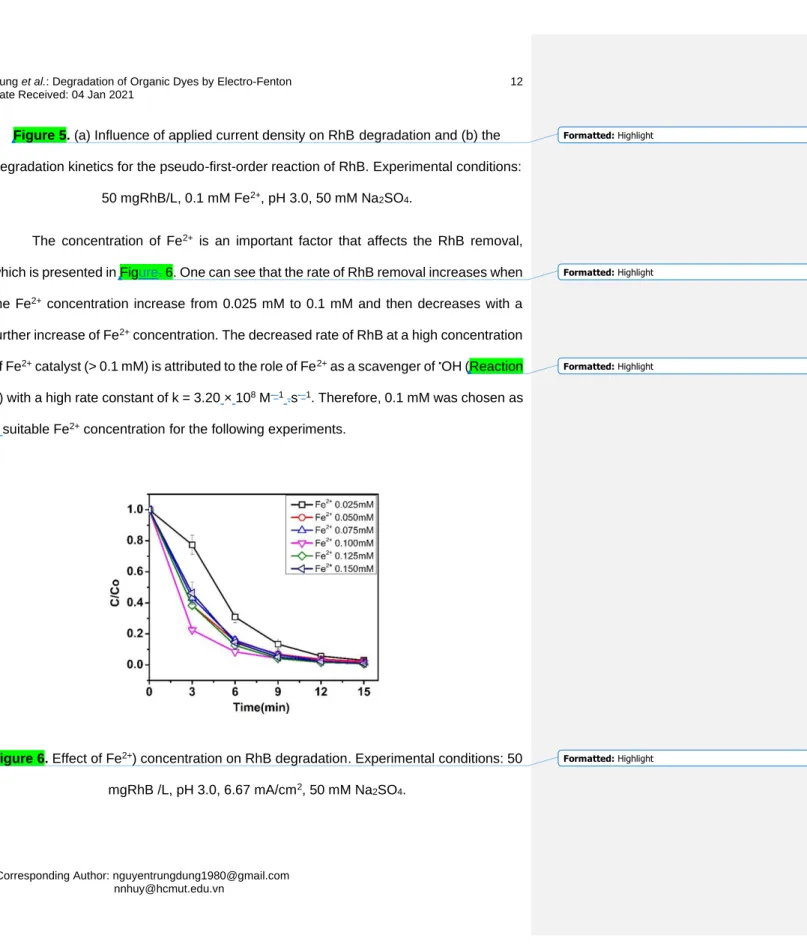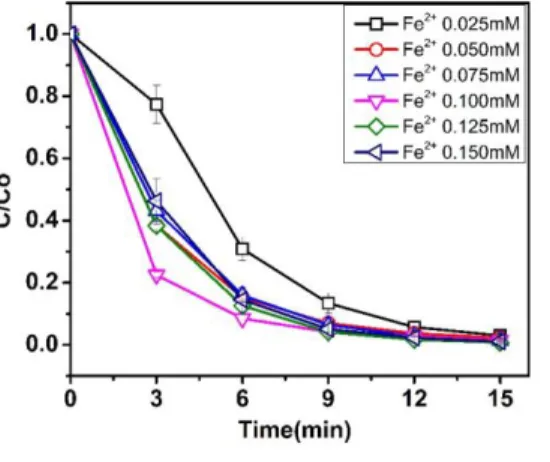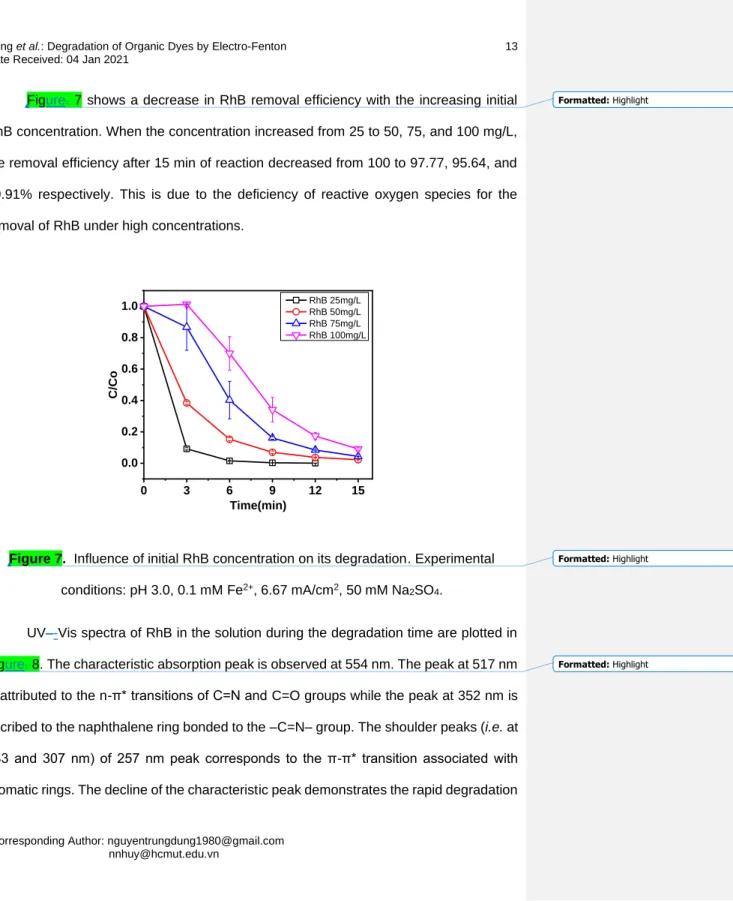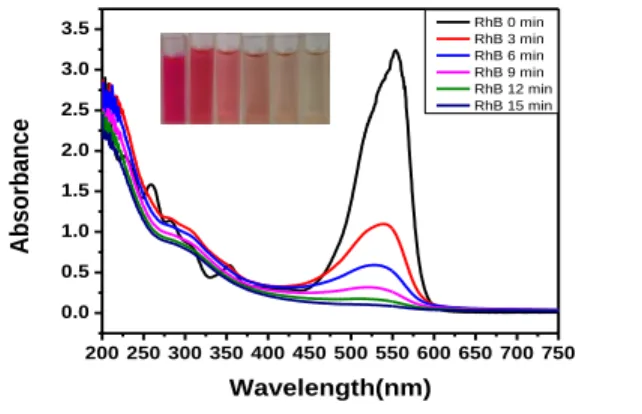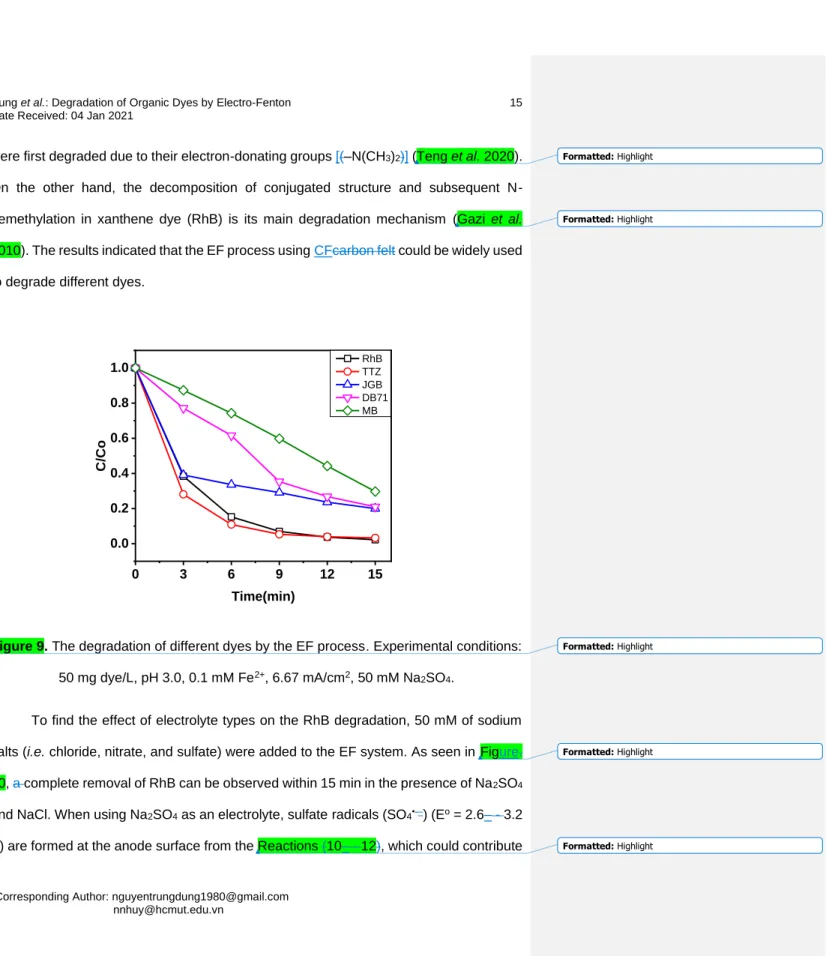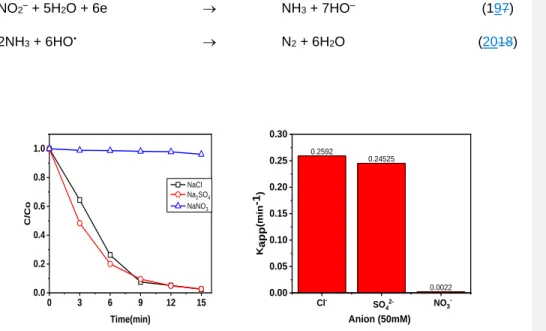Effect of Environmental Factors on the Degradation of Organic Dyes by Electro- 1
Fenton Using Carbon Felt Cathode 2
3
Nguyen Trung Dung1*, Le Thuy Duong1, Nguyen Thi Hoa1, 4
and Nguyen Nhat Huy2,3,* 5
6
1Faculty of Physical and Chemical Engineering, Le Quy Don Technical University 7
236 Hoang Quoc Viet St., Bac Tu Liem District, Hanoi, Vietnam 8
2Faculty of Environment and Natural Resources 9
Ho Chi Minh City University of Technology (HCMUT) 10
268 Ly Thuong Kiet St., District 10, Ho Chi Minh City, Vietnam 11
3Vietnam National University Ho Chi Minh City 12
Linh Trung Ward, Thu Duc District, Ho Chi Minh City, Vietnam 13
14
Keywords: advanced oxidation process, carbon felt, 15
Electro-Fenton process, organic dyes, wastewater treatment 16
17
ABSTRACT 18
In this study, an electro-Fenton (EF) process using carbon felt (CF) as the cathode 19
and titanium/platinum (Ti/Pt) as the anode was tested for removing Rhodamine 20
rhodamine B (RhB) and other organic dyes in water. Characterization of the CFcarbon 21
felt material was conducted by scanning electron microscopy (SEM) and X-ray powder 22
diffraction (XRD). The influence of various environmental factors (i.e. solution pH, current 23
density, catalyst dosage, RhB concentration, and type of dyes and electrolytes) on the 24
dye removal was investigated. The results show that the maximum removal efficiency of 25
RhB was 98% within 15 min at the optimal conditions of 50 mgRhB/L, 0.05 M Na2SO4, 26
pH 3, 0.1 mM Fe2+, and 6.67 mA/cm2. The decomposition of RhB follows a pseudo-first- 27
order model with the decomposition rate constant of 0.256 min-–1. Radical quenching 28
experiments show that superoxide plays a key role in RhB degradation. Finally, results 29
show that CFcarbon felt has high stability and degradation efficiency, which is suitable as 30
a cathode for the removal of organic dyes in wastewater.
31
32
INTRODUCTION 33
Textile wastewater is one of the most popular types of industrial wastewater in 34
developing countries such as Vietnam, which is characterized by high color, COD, BOD, 35
and soluble dyes. Among the dyes, Rhodamine B (RhB) is an essential cationic xanthene 36
dye (Figure .1), which is fast color, inexpensive, and widely used in the industry. Since 37
RhB and other dyes are toxic and hazardous (Nidheesh et al. 2014), the removal of these 38
dyes is necessary before discharging them into the water environments. There are many 39
techniques to remove RhBRhodamine B in water, such as adsorption (Wu et al. 2020;
40
Xiao et al. 2020), membrane separation (Saja et al. 2020; Sundaran et al. 2019), and 41
advanced oxidation processes (AOPs) – including catalytic activation (Pang et al. 2019;
42
Zhu et al. 2019), photocatalysis (Yang et al. 2020; Zhang et al. 2020a), Fenton (Hou et 43
al. 2011), photo-Fenton (Gao et al. 2015), UV/EFelectro-Fenton (Zhang et al. 2020b), and 44
EFelectro-Fenton (Yuan et al. 2011; Ai et al. 2008; Nidheesh and Gandhimathi 2014a, b;
45
Nidheesh et al. 2014; Nidheesh and Gandhimathi 2014a; Tian et al. 2016). Among them, 46
electro-Fenton (the EF) process is one of the most effective methods for the fast 47
degradation of persistent organic pollutants. Since EF is one of the Fenton processes, it 48
still has some similar limitations to the traditional Fenton process, such as low working 49
pH, consumption of acid for reaction and alkali for neutralization, as well as the 50
Formatted: Highlight Formatted: Highlight
Formatted: Highlight
Formatted: Highlight Formatted: Highlight Formatted: Highlight Formatted: Highlight Formatted: Highlight Formatted: Highlight Formatted: Highlight Formatted: Highlight Formatted: Highlight Formatted: Highlight Formatted: Highlight Formatted: Highlight Formatted: Highlight Formatted: Highlight Formatted: Highlight Formatted: Highlight Formatted: Highlight
requirement of electricity use. However, the EF process has many advantages such as 51
high flexibility, easy ease tof control, automation, high efficiency, and environmental 52
compatibility. Moreover, the EF process is also better than the conventional Fenton 53
process in terms of (i) the in -situ H2O2 production and (ii) the continuous Fe2+
54
regeneration, which provides an easy chemical operation, improves the oxidation 55
process, and reduces the sludge production.
56
57
Figure 1. Structure of RhBrhodamine B.
58
The principle of the EF process is similar to that of the conventional Fenton 59
process, which is the generation of hydroxyl radicals (•OH, Reaction 1) and its 60
consumption by the organics (Reaction 2). Here, Fe2+ is externally added and 61
regenerated by electrochemical reduction (Reaction 3), while H2O2 is on-site supplied 62
from the cathode by the reduction of oxygen in water (Reaction 4). H2O2 can also be 63
decomposed into H2O and O2 at high solution pH values (Reaction 5) or reacts with •OH 64
(Reaction 6). The •OH can also be consumed by Fe2+ under a high concentration of Fe2+
65
but a low concentration of reductants (e.g. organics) (Reaction 7).
66
H2O2 + Fe2+ → Fe3+ + OH– + •OH (1)
Formatted: Font: Italic
Formatted: Highlight
Formatted: Highlight Formatted: Highlight Formatted: Highlight Formatted: Highlight Formatted: Highlight Formatted: Highlight Formatted: Highlight
Formatted: Highlight
RH + •OH → R• + H2O (2)
Fe3+ + e → Fe2+ (3)
O2 + 2H+ + 2e → H2O2 (4)
2H2O2 → 2H2O + O2 (5)
2•OH + H2O2 → 2H2O + O2 (6)
Fe2+ + •OH → Fe3+ + OH– (7)
Several electro-FentonEF parameters affect its efficiency for water treatment, such 67
as electrode material, catalyst concentration, current density, and solution pH. Among 68
them, the cathode material is important because it determines the H2O2 production and, 69
therefore, affects the •OH generation rate (Reaction 1). Carbonaceous materials are 70
commonly used as cathodes, including carbon foam, CFcarbon felt, boron-doped 71
diamond, graphite, and graphite felt. With good stability, high conductivity, high surface 72
area, abundant resources, and low cost, carbon felt (CF) is a good candidate for use as 73
cathode material in electrochemistry (Huong Le et al. 2017; Mi et al. 2019). There have 74
been several reports of using CF as a cathode for EFelectro-Fenton. In the work of 75
Pimentel et al. (2008), the EF process could remove 100% of total organic carbon (TOC) 76
in phenol treatment under optimum conditions of 10−4 M of FeSO4. Sirés et al. (2007) also 77
using CF as cathode for EF treatment of antimicrobial triclosan and triclocarban. Dyes 78
such as triphenylmethane (e.g. malachite green, crystal violet, methyl green, and fast 79
green FCF) and azo (e.g. azobenzene, p-methyl red, and methyl orange) were effectively 80
treated by EF process using CF cathode (Sirés et al. 2008; Guivarch et al. 2003).
81
Moreover, the pesticide (Zazou et al. 2016; Tran et al. 2019) and antibiotics (Wu et al.
82
2012; El-Ghenymy et al. 2014) in water was also efficiently removed and mineralized by 83
Formatted: Highlight Formatted: Highlight Formatted: Highlight Formatted: Highlight Formatted: Highlight Formatted: Highlight
Formatted: Highlight
Formatted: Highlight Formatted: Highlight
Formatted: Highlight Formatted: Highlight
Formatted: Highlight Formatted: Highlight Formatted: Highlight Formatted: Highlight Formatted: Highlight Formatted: Highlight
EF treatment using CF cathode. However, there is very limited information on the 84
application of CFcarbon felt as cathode for removal of RhBRhodamine B in water and on 85
the effect of environmental factors on the efficiency of the EFelectro-Fenton process.
86
In this work, we used commercially available CFcarbon felt as a cathode electrode 87
for the EF process and tested its performance for the removal of RhB as well as other 88
dyes in water. The effects of environmental factors such as solution pH, applied current 89
density, Fe2+ concentration, and RhB concentration were investigated. The role of 90
electrolytes and reactive oxidation species were also determined.
91
92
MATERIALS AND METHODS 93
All chemicals used in this study are pure chemicals with a purity of ≥ 99%.
94
Chemicals such as Rhodamine B (RhB), Tartrazine tartrazine (TTZ), Janus Green green 95
B (JGB), Direct direct Blue blue 71 (DB71), Methylene methylene Blue blue (MB), p- 96
benzoquinone (p-BQ), furfuryl alcohol (FFA), and tert-butanol alcohol (TBA) were 97
purchased from Shanghai Macklin (China). Other chemicals such as FeSO4.7H2O, 98
Na2SO4, NaCl, NaNO3, H2SO4, and NaOH were obtained from Xilong (China). CFCarbon 99
felt was supplied by Hebei Xingshi (China). Double-distilled water was taken locally from 100
the lab.
101
The morphology of the CFcarbon felt was determined by scanning electron 102
microscopySEM (SEM, Hitachi S-4800, Japan)., The X-ray powder diffraction (XRD) 103
pattern was collected by a Bruker D8 Advance X-ray diffractometer with Cu Ka radiation 104
(λ = 1.5406 Å) with a step scan of 0.02o and step time of 1 s. The absorbance of the 105
solution was measured by a UV-Vis spectrophotometer (Biochrom SP-60, UK).
106
The experiments for EFelectro-Fenton degradation of RhB were conducted at 107
room conditions in a 500- mL glass beaker (Figure. 2). In the reactor, CFcarbon felt with 108
a dimension of 12 cm × 5 cm was used as cathode and Pt/Ti material was used as an 109
anode. The anode and cathode were placed parallel and the distance between them was 110
set at 3 cm in all the experiments. Electrolyte (50 mM Na2SO4) was added into the dye 111
(50 mg/L RhB) solution and stirred vigorously and the solution pH was adjusted to 3 by 112
using sulfuric acid. The solution was aerated 15 min before and kept aeration during the 113
experiment. FeSO4 (0.1 mM) was used as a Fenton catalyst and a constant DC current 114
of 400 mA (BC 1830, LiOA, Vietnam) was used as a current supply. All the experiments 115
were repeated 3 three times and the average results, as well as their standard deviations, 116
were reported.
117
118
Figure 2. Schematic presentation of the EFelectro-Fenton system.
119
Cathode:
Carbon Felt (12x5cm2)
Anode: Ti/Pt (10x5cm2) Oxygen
H2O2
Fenton reaction: Fe2+ + + Fe(OH)2+ + OH
RH + OH R + H2O
H2O2 OH
OH
Formatted: Highlight
Formatted: Highlight
120
During the reaction, water samples with a volume of 4 mL were taken, centrifuged, 121
and sent for absorbance measurement at 554 nm to determine the RhB concentration. In 122
this study, the EF process was also applied for other dyes in different types of xanthene 123
(e.g. RhB), azo (e.g. TTZ, DB71, and JGB) and thiazine (e.g. MB) to evaluate the 124
possibility of the EF process for treatment of various types of dyes in practical 125
applications. The experiments for other dyes were conducted under the same condition 126
of RhBRhodamine B and the concentrations of the dyes were measured at wavelengths 127
of 428, 587, 654, and 664 nm for TTZ, DB71, JGB, and MB, respectively. The calculation 128
for removal efficiency and the fitting of the pseudo-first-order kinetic model for the removal 129
of RhB are as follows (Afanga et al. 2021):.
130
H(%) = (1 – Ct/Co) × 100 (8)
ln(Ct /C0) = kapp × t (9)
where Co and Ct (mg/L) are the concentration of RhB at the beginning and after the 131
reaction, respectively, and kapp (min-–1) is the rate constant for the pseudo-first-order 132
kinetic model.
133
To investigate the key reactive oxygen species involved in RhB degradation, three 134
scavengers (i.e. 50 mM TBA, 1 mM p-BQ, and 50 mM FFA) were added to quench 135
hydroxyl radical (kTBA-HO• = 3.8–-7.6 × 108 M–-1 .s –-1), superoxide radical (kpBQ-O2●- = 9.8 × 136
108 M–-1 .s –-1 ), and singlet oxygen (kFFA-1
O2 = 1.2 × 108 M–-1 .s –-1) (Yu et al. 2020; Chen 137
et al. 2020), respectively, before turning on the electricity for EF process.
138
Formatted: Highlight
Formatted: Highlight Formatted: Highlight
The recyclability of the electrodes was also conducted via 5 five cycles of RhB 139
treatment by the EF process. After each experiment, the used CFcarbon felt electrode 140
was washed thoroughly with distilled water and ethanol to remove the organics. After that, 141
the electrodes were dried at 80 °oC in an oven and then reused for the next cycle of RhB 142
removal by the EF process.
143
144
RESULTS AND DISCUSSION 145
Characteristics of the Carbon FeltCF Cathode 146
As shown in Figure. 3(a), the commercial CFs are fine fibers with a diameter of 147
about 20 m. They have a clean and smooth surface, which is free of adhered organic 148
and inorganic impurities. The fibers are randomly dispersed with a relatively 149
homogeneous space between them. The XRD pattern of CF is displayed in Figure 3(b).
150
There are two weak peaks observed at 2θ of around 25o and 43°o, which correspond to 151
the (002) and (100) crystal planes of the CF material. These results also indicate the 152
amorphous structure of CF, which is consistent with previous work (Ganiyu et al. 2017;
153
Huong Le et al. 2017).
154
Formatted: Highlight
Formatted: Highlight
Formatted: Highlight Formatted: Highlight
155
Figure 3. (a) SEM images and (b) XRD pattern of the CFcarbon felt cathode.
156
Degradation of Rhodamine B by EF Process Using CF Cathode 157
The effect of pH on the performance of the EF process for RhB removal was 158
investigated in the initial pH range of 2.0, 2.5, 3.0, 3.5, and 4.0. As seen in Figure. 4(a), 159
high RhB removal efficiencies of around 98% were observed in a narrow pH range from 160
2.0– to 3.5 after 15 min of treatment, while the efficiency was only at 3.2% for pH 4.0. The 161
acidic conditions favor the formation of H2O2 at the cathode. Also, the hydroxyl radical 162
has stronger oxidation properties under acidic conditions than under neutral or basic 163
conditions. When pH ≥ 4, H2O2 was preferentially broken down into O2 and H2O (Reaction 164
5), while Fe2+ and Fe3+ forms iron hydroxide complexes, thus reducing the Fe(III) catalyst 165
in the solution and lose its activity. These lead to a decrease in the formation of reactive 166
oxygen species and, therefore, the RhB degradation efficiency (Lin et al. 2014; Nidheesh 167
et al. 2014) since the main removal mechanism is via coagulation or adsorption. Although 168
pH 2 shows slightly better removal efficiency than pH 3, running the EF process at pH 2 169
consumes a sustainably higher amount of acid than that at pH 3 and requires much more 170
(a) (b)
Formatted: Highlight
Formatted: Highlight
Formatted: Highlight
Formatted: Highlight Formatted: Highlight
alkali solution for neutralization after treatment. Also, a very low pH of 2 could easily cause 171
corrosion issues for the equipment in water treatment. Therefore, pH 3 was chosen as a 172
suitable pH for further EFelectro-Fenton experiments. The pH change according to the 173
degradation time of RhB was also investigated. The results in Figure. 4(b) show that there 174
was a slight pH increase during the first 3 min of reaction, which may be due to the 175
production of OH-– by EF process. After that, there was a slight decrease in pH value, 176
which could be due to the formation of short-chain carboxylic acids during the EF process 177
(Nidheesh et al. 2014; Gao et al. 2015). Generally, it can be considered that the solution 178
pH value is relatively stable during the EF process.
179
0 3 6 9 12 15
0.0 0.2 0.4 0.6 0.8 1.0
C/Co
Time(min)
pH=2.0 pH=2.5 pH=3.0 pH=3.5 pH=4.0
0 3 6 9 12 15
1.5 2.0 2.5 3.0 3.5 4.0 4.5 5.0 5.5
pH
Time (min)
pH = 2 pH = 2.5 pH = 3 pH = 3.5 pH = 4
180
Figure 4. (a) Effect of initial solution pH on the EF removal of RhB and (b) pH change 181
with time during the EF process. Experimental conditions: 50 mgRhB/L, 0.1 mM Fe2+, 182
6.67 mA/cm2, 50 mM Na2SO4. 183
The applied current density affects the formation rate of both H2O2 (Reaction 4) 184
and •OH (Reaction 1). The experiments were conducted in the current density range from 185
1.67– to 8.33 mA/cm2 (Figure. 5(a)). The degradation of RhB well fitted with the first-order 186
(a) (b)
Formatted: Highlight
Formatted: Highlight Formatted: Highlight
Formatted: Highlight
Formatted: Highlight Formatted: Highlight Formatted: Highlight
kinetics equation (Figure. 5(b)) with R2 ≥ 0.98. The degradation rate constant of RhB 187
increased by 3 three times (i.e. from 0.08324 to 0.255 min-–1) when the current density 188
increased from 1.67– to 6.67 mA/cm2. After 15 min of the experiment (Figure. 5(a)), the 189
RhB removal efficiencies were 76.57, 92.21, 96.51, 97.77, and 94.80% at 1.67, 3.33, 190
5.00, 6.67, and 8.33 mA/cm−2, respectively, indicating a proportional relationship of RhB 191
degradation and current density in the range of 1.67– to 6.67 mA/cm2. This is due to an 192
increase in the electrochemical formation of H2O2 (Reaction 4), which increases the 193
conversion of Fe3+ to Fe2+ with the increased current density (Annabi et al. 2016). Since 194
RhB is a cationic dye, it is more attracted towards the cathode under higher current 195
density. This increases the frequency of collisions between dyes molecule and reactive 196
oxygen species, thus improves the RhB removal in water. However, as the applied current 197
density continued to increase to 8.33 mA/cm2, the RhB decomposition efficiency 198
decreased. The cause may be due to the degradation reactions of H2O2 and other 199
reactive oxygen species (Reactions 5 and 6) at high current density (Lin et al. 2017), 200
resulting in a reduced rate of RhB decomposition. Therefore, the current density of 6.67 201
mA/cm2 was selected for the next experiments.
202
203
Formatted: Highlight
Formatted: Highlight
Formatted: Highlight Formatted: Highlight
Formatted: Highlight Formatted: Highlight Formatted: Highlight Formatted: Highlight
Figure 5. (a) Influence of applied current density on RhB degradation and (b) the 204
degradation kinetics for the pseudo-first-order reaction of RhB. Experimental conditions:
205
50 mgRhB/L, 0.1 mM Fe2+, pH 3.0, 50 mM Na2SO4. 206
The concentration of Fe2+ is an important factor that affects the RhB removal, 207
which is presented in Figure. 6. One can see that the rate of RhB removal increases when 208
the Fe2+ concentration increase from 0.025 mM to 0.1 mM and then decreases with a 209
further increase of Fe2+ concentration. The decreased rate of RhB at a high concentration 210
of Fe2+ catalyst (> 0.1 mM) is attributed to the role of Fe2+ as a scavenger of •OH (Reaction 211
7) with a high rate constant of k = 3.20 × 108 M-–1 .s-–1. Therefore, 0.1 mM was chosen as 212
a suitable Fe2+ concentration for the following experiments.
213
214
Figure 6. Effect of Fe2+) concentration on RhB degradation. Experimental conditions: 50 215
mgRhB /L, pH 3.0, 6.67 mA/cm2, 50 mM Na2SO4. 216
Formatted: Highlight
Formatted: Highlight
Formatted: Highlight
Formatted: Highlight
Figure. 7 shows a decrease in RhB removal efficiency with the increasing initial 217
RhB concentration. When the concentration increased from 25 to 50, 75, and 100 mg/L, 218
the removal efficiency after 15 min of reaction decreased from 100 to 97.77, 95.64, and 219
90.91% respectively. This is due to the deficiency of reactive oxygen species for the 220
removal of RhB under high concentrations.
221
0 3 6 9 12 15
0.0 0.2 0.4 0.6 0.8 1.0
C/Co
Time(min)
RhB 25mg/L RhB 50mg/L RhB 75mg/L RhB 100mg/L
222
Figure 7. Influence of initial RhB concentration on its degradation. Experimental 223
conditions: pH 3.0, 0.1 mM Fe2+, 6.67 mA/cm2, 50 mM Na2SO4. 224
UV–-Vis spectra of RhB in the solution during the degradation time are plotted in 225
Figure. 8. The characteristic absorption peak is observed at 554 nm. The peak at 517 nm 226
is attributed to the n-π* transitions of C=N and C=O groups while the peak at 352 nm is 227
ascribed to the naphthalene ring bonded to the –C=N– group. The shoulder peaks (i.e. at 228
283 and 307 nm) of 257 nm peak corresponds to the π-π* transition associated with 229
aromatic rings. The decline of the characteristic peak demonstrates the rapid degradation 230
Formatted: Highlight
Formatted: Highlight
Formatted: Highlight
of RhB in the first 3 min. The disappearance of the adsorption band during reaction time 231
indicates the degradation in the structure of RhB molecules by the reactive oxygen 232
species produced during the EF process.
233
234
Figure 8. UV-Vis spectra of RhB at different degradation times. Experimental 235
conditions: 50 mg RhB/L, pH 3.0, 0.1 mM Fe2+, 6.67 mA/cm2, 50 mM Na2SO4. 236
To determine the applicability of the EF process in practical wastewater, the 237
optimal condition of the EF process was applied for the decomposition of different groups 238
of dyes such as azo dyes (i.e. TTZ, DB71, and JGB), phenothiazine (i.e. MB), and 239
xanthene (i.e. RhB). Figure. 9 shows a decreasing order of decomposition efficiency as 240
RhB (98%) TTZ (97%) > JGB (80%) DB71 (79%) > MB (70%). The difference in the 241
degradation efficiency of dyes can be attributed to the difference in their structures. The 242
easy dissociation of π-bondings (e.g. to form naphthalene ring) of TTZ, DB71, and JGB 243
(with –N=N–- color centers) make them easier to be degraded (Oancea and Meltzer 2013;
244
Maleki et al. 2015). Regarding thiazine dye (MB), aromatic ring-bonded nitrogen atoms 245
200 250 300 350 400 450 500 550 600 650 700 750 0.0
0.5 1.0 1.5 2.0 2.5 3.0
3.5 RhB 0 min
RhB 3 min RhB 6 min RhB 9 min RhB 12 min RhB 15 min
Absorbance
Wavelength(nm)
Formatted: Highlight
Formatted: Highlight
Formatted: Highlight Formatted: Highlight
were first degraded due to their electron-donating groups [(–N(CH3)2)] (Teng et al. 2020).
246
On the other hand, the decomposition of conjugated structure and subsequent N- 247
demethylation in xanthene dye (RhB) is its main degradation mechanism (Gazi et al.
248
2010). The results indicated that the EF process using CFcarbon felt could be widely used 249
to degrade different dyes.
250
0 3 6 9 12 15
0.0 0.2 0.4 0.6 0.8 1.0
C/Co
Time(min)
RhB TTZ JGB DB71 MB
251
Figure 9. The degradation of different dyes by the EF process. Experimental conditions:
252
50 mg dye/L, pH 3.0, 0.1 mM Fe2+, 6.67 mA/cm2, 50 mM Na2SO4. 253
To find the effect of electrolyte types on the RhB degradation, 50 mM of sodium 254
salts (i.e. chloride, nitrate, and sulfate) were added to the EF system. As seen in Figure.
255
10, a complete removal of RhB can be observed within 15 min in the presence of Na2SO4
256
and NaCl. When using Na2SO4 as an electrolyte, sulfate radicals (SO4•-–) (Eo = 2.6– - 3.2 257
V) are formed at the anode surface from the Reactions (10– - 12), which could contribute 258
Formatted: Highlight
Formatted: Highlight
Formatted: Highlight
Formatted: Highlight
Formatted: Highlight
to the decomposition of RhBRhodamine B. Sulfate radical has a long existence time in 259
the solution and has a strong redox ability, which facilitates the selective oxidation of 260
organic pollutants in water (Hai et al. 2020).
261
2SO42– → S2O82– + 2e (810)
S2O82– + e → SO4•– + SO42– (119)
2SO42– + HO• → SO4•– + HO– (120)
In the case of NaCl, active chlorine forms (e.g. Cl2, HClO, ClO-–, and Cl•) are 262
formed in solution by the direct oxidation of the chloride anion at the anode surface, which 263
also enhances the degradation of RhB. However, these chlorine forms can also react with 264
organics to form chlorinated organics, which are hazardous compounds.
265
2Cl– → Cl2 + 2e (131)
Cl2 + H2O → HClO + HCl (142)
2Cl– + HO• → Cl• + HO– (153)
Cl• + Cl• → Cl2 (164)
However, with NaNO3, there was complete inhibition of RhB degradation. This can 266
be explained that nitrate ions and nitrite are reduced at the cathode to form ammonia, 267
which can react with hydroxyl radicals, leading to the inhibition of RhB degradation. The 268
degradation rate constant (kapp) of RhB using NaNO3 was 0.0022 min-–1, which was 110 269
and 120 times lower than those using NaCl and Na2SO4, respectively.
270
NO3– + 6H2O + 8e → NH3 + 9HO– (175)
NO3– + 2H+ + 2e → NO2– + H2O (186)
Formatted: Highlight
Formatted: Pattern: Clear (Green) Formatted: Highlight
Formatted: Not Highlight Formatted: Not Highlight
NO2– + 5H2O + 6e → NH3 + 7HO– (197)
2NH3 + 6HO• → N2 + 6H2O (2018)
271
0 3 6 9 12 15
0.0 0.2 0.4 0.6 0.8 1.0
C/Co
Time(min)
NaCl Na2SO4 NaNO3
0.2592
0.24525
0.0022
0.00 0.05 0.10 0.15 0.20 0.25 0.30
Kapp(min-1)
Anion (50mM) Cl- SO42- NO3-
272
Figure 10. (a) Effects of electrolyte on RhB degradation and (b) the degradation rate 273
constant. Experimental conditions: 50 mg RhB/L, pH 3.0, 0.1 mM Fe2+, 6.67 mA/cm2, 50 274
mM of electrolyte.
275
As illustrated in Figure. 11, the RhB degradation efficiency decreased from 98% to 276
85%, 81%, and 36% when using TBA, FFA, and p-BQ, respectively. Therefore, the role 277
of the reactive species is in the other of O2●–- > 1O2 HO●, proving the role of oxygen in 278
the formation of reactive oxygen species. When replacing air with pure nitrogen gas, the 279
degradation efficiency decreased from 98% to 68%. Thus, oxygen plays an important role 280
in forming active oxygen species (e.g. O2●–-, 1O2, and HO●), which determine the 281
degradation efficiency of RhB.
282
Formatted: Highlight
Formatted: Highlight
0 2 4 6 8 10 12 14 16 0.0
0.2 0.4 0.6 0.8 1.0
C/Co
Time(min)
No Scavenger TBA 50mM FFA 50mM N2 p-BQ 1mM
283
Figure 11. RhB degradation in the presence of different radical scavengers.
284
Experimental conditions: 50 mgRhB/L, pH 3.0, 0.1 mM Fe2+, 6.67 mA/cm2, 50 mM 285
Na2SO4, 50 mM of scavenger.
286
The stability of the cathode electrode is an essential issue for practical 287
applications. As seen in Figure. 12, it is interesting that there was no apparent decrease 288
in the RhB degradation efficiency during 5 five cycles of RhB treatment by EF process, 289
indicating that the CFcarbon felt is very stable and reusable, which is a very potential 290
electrode for practical wastewater treatment using the EFelectro-Fenton system.
291
Formatted: Highlight
Formatted: Highlight
0.0 0.2 0.4 0.6 0.8 1.0
0 5 10 15 0 5 10 15 0 5 10 15 0 5 10 15 0 5 10 15
C/Co
1 2
Time(min)
3 4 5
292
Figure 12. RhB degradation using recycled CFcarbon felt as cathode.
293
Table 1 summarizes the main results using CFcarbon felt as a cathode electrode 294
in the EF process to remove various organic pollutants such as dyes, antibiotics, and 295
pesticides. In most cases, the complete degradation of organic pollutants is considered 296
to be the oxidation role of HO●. However, our research proved that RhB decomposition 297
involves different types of active oxygen, in which superoxide radical plays a decisive 298
role.
299
Table 1. Removal of organic pollutants by EF process using CFcarbon felt as the cathode 300
electrode.
301
Formatted: Highlight
Formatted: Highlight
Formatted: Highlight
Cathode electrode
Organic pollutants
EF conditions Efficiency Reference
Carbon feltCF
(12 cm × 5 cm)
Rhodamine B
(RhB, C28H31ClN2O3)
[RhB] = 50 mg/L
pH = 3.0
[Fe(II)] = 0.1 mM
[Na2SO4] = 50 mM Anode: Ti/Pt (10 cm × 5 cm);
Applied current density:
6.67 mA.cm–2
Degradation of 98%
RhB in 15 min of electrolysis
Oxidation rate constant: 0.255 min–1
Order of reactive oxygen species: O2*–
> 1O2 HO●
Present
study
Carbon feltCF
(16 cm × 7 cm)
Orange II
(C16H11N2NaO4S)
[Orange II] = 50 mg/L
pH = 3.0
[Fe(III)] = 0.2 mM
Anode: RuO2-IrO2
[Na2SO4] = 50 mM
Applied current density:
1.78 mA.cm–2
Degradation of 97.8% Orange II in 10 min of electrolysis
HO● played an important role in the oxidation process.
Lin et al.
(2014)
Carbon feltCF
(10 cm × 5 cm)
Glyphosate
(Gly, C3H8NO5P)
[Gly] = 0.1 M
pH = 3
Degradation of 91.91% Gly in 40 min of electrolysis
Tran et al.
(2019)
Formatted: Highlight
Formatted: Highlight
Anode: Pt (8 cm × 4 cm)
Applied current density:
10 mA.cm–2
Oxidation rate constant: 0.063 min–1
HO● played an important role in the oxidation process.
Carbon FeltCF
(8 cm × 6 cm)
Benzoic acid
(C7H6O2)
[Benzoic acid] = 0.2 mM
pH = 3
[Fe(II)] = 0.3 mM Anode:
BDD (8 cm × 5 cm)
Applied current density:
6.25 mA.cm–2
Degradation of 89%
Benzoic acid in 60 min and 95% in 120 min of electrolysis
Sennaoui et al. (2019)
Carbon feltCF
(15 cm × 4 cm)
Paraaminosalicyli c acid
(PAS, C7H7NO3)
[PAS] = 0.1 mM (15.3 mg/L)
pH = 3
[Fe(II)] = 0.1 mM
[Na2SO4] = 50 mM
Applied current density:
8.33 mA.cm-2
Anode: Pt and BDD
Degradation of 100%
PAS in 7 min of electrolysis using Pt/carbon-felt cell and in 10 min using BDD/carbon-felt cell
Oxidation rate constant: 4.17 × 109 M–1 s–1
Oturan et al.
(2018)
Formatted: Highlight
Formatted: Highlight
HO● played an important role in the oxidation process.
Carbon FeltCF
(17.5 cm × 6 cm)
Sucralose
(SUS, C12H19Cl3O8)
[SUC] = 80 mg/L
pH = 3
[Fe(II)] = 0.2 mM
[Na2SO4] = 50 mM
Anode: BDD (25 cm2)
Applied current density:
1.9 mA.cm–2
Remove 96.1 % TOC of SUC in 120 min of electrolysis
HO● played an important role in the oxidation process.
Lin et al.
(2017)
Carbon feltCF
(70 cm2)
Enoxacin (ENXN, C15H17FN4O3)
[ENXN] = 50mg/L pH = 3
[Fe(II)] = 0.2 mM [Na2SO4] = 50 mM
Anode: BDD (5 cm × 4 cm)
Applied current density:
4.286 mA.cm–2
Degradation of 98%
ENXN in 60 min of electrolysis
HO● played an important role in the oxidation process.
Annabi et al.
(2016)
Carbon feltCF
(14 cm × 5 cm)
Norfloxacin
(Nor, C16H18FN3O3)
[Nor] = 0.25 mM
pH = 3
[Fe(III)] = 0.1 mM
Remove 98 % TOC of Nor in 5 h of electrolysis
Özcan et al.
(2016)
Formatted: Highlight
Formatted: Highlight
Formatted: Highlight
Anode: Pt and BDD (5 cm
× 4 cm)
Applied current density:
4.286 mA.cm–2
Carbon feltCF
(60 cm2)
Levofloxacin (Levo, C18H20FN3O4)
[Levo] = 83.6 mg/L
pH = 3
[Fe(II)] = 0.2 mM
Anode: BDD (6 cm2)
Applied current density: 5 mA.cm–2
Remove 85 % TOC of Levo in 8 h of electrolysis
HO● played an important role in the oxidation process.
Barhoumi et al. (2015)
Carbon feltCF
(20 cm × 4 cm)
Tetracycline
(TC, C22H24N2O8)
[TC] = 80 mg/L
pH = 3
[Fe(II)] = 0.1 mM
[Na2SO4] = 50 mM
Anode: Ti/RuO2-IrO2 (36 cm2)
Applied current density: 5 mA.cm–2
Remove 83.9 % TOC of TC in 8 h of electrolysis
HO● played an important role in the oxidation process.
Chen et al.
(2019)
302
CONCLUSIONS 303
Formatted: Highlight
Formatted: Highlight
A comprehensive study was conducted to investigate the effect of environmental 304
factors on the removal of RhB via the EFelectro-Fenton process using CFcarbon felt as 305
the cathode material. The suitable condition was determined at RhB concentration of 50 306
mg/L, pH 3.0, Fe2+ concentration of 0.1 mM, current density of 6.67 mA/cm2, and 307
electrolyte of 50 mM Na2SO4. The effect of radical scavenger was also conducted, 308
showing a decisive role of superoxide radical. The durability of the CFcarbon felt cathode 309
was also tested by cycle test, which proves its stability for practical applications in 310
wastewater treatment.
311
312
REFERENCES 313
AFANGA H, ZAZOU H, TITCHOU FE, GAAYDA JE, SOPAJ F, AKBOUR RA, HAMDANI 314
M. 2021. Electrochemical oxidation of Naphthol Blue Black with different supporting 315
electrolytes using a BDD /carbon felt cell. J Environ Chem Eng 9(1): 104498.
316
AI Z, XIAO H, MEI T, LIU J, ZHANG L, DENG K, QIU J. 2008. Electro-Fenton Degradation 317
of Rhodamine B Based on a Composite Cathode of Cu2O Nanocubes and Carbon 318
Nanotubes. J Phys Chem C 112(31): 11929–11935.
319
ANNABI C, FOURCADE F, SOUTREL I, GENESTE F, FLONER D, BELLAKHAL N, 320
AMRANE A. 2016. Degradation of enoxacin antibiotic by the electro-Fenton process:
321
optimization, biodegradability improvement and degradation mechanism. J Environ 322
Manage 165: 96–105.
323
Formatted: Highlight Formatted: Highlight
Formatted: Highlight Formatted: Highlight
Formatted: Highlight Formatted: Highlight
BARHOUMI N, LABIADH L, OTURAN MA, OTURAN N, GADRI A, AMMAR S, BRILLAS 324
E. 2015. Electrochemical mineralization of the antibiotic levofloxacin by electro- 325
Fenton-pyrite process. Chemosphere 141: 250–257.
326
CHEN S, TANG L, FENG H, ZHOU Y, ZENG G, LU Y, YU J, REN X, PENG B, LIU X.
327
2019. Carbon felt cathodes for electro-Fenton process to remove tetracycline via 328
synergistic adsorption and degradation. Sci Total Environ 670: 921–931.
329
CHEN Z, BI S, ZHAO G, CHEN Y, HU Y. 2020. Enhanced degradation of triclosan by 330
cobalt manganese spinel-type oxide activated peroxymonosulfate oxidation process 331
via sulfate radicals and singlet oxygen: mechanisms and intermediates identification.
332
Sci Total Environ 711: 134715.
333
EL-GHENYMY A, RODRÍGUEZ RM, BRILLAS E, OTURAN N, OTURAN MA. 2014.
334
Electro-Fenton degradation of the antibiotic sulfanilamide with Pt/carbon-felt and 335
BDD/carbon-felt cells: kinetics, reaction intermediates, and toxicity assessment.
336
Environ Sci Pollut Res 21(14): 8368–8378.
337
GANIYU SO, HUONG LE TX, BECHELANY M, ESPOSITO G, VAN HULLEBUSCH ED, 338
OTURAN MA, CRETIN M. 2017. A hierarchical CoFe-layered double hydroxide 339
modified carbon-felt cathode for heterogeneous electro-Fenton process. J Mater 340
Chem A 5(7): 3655–3666.
341
GAO Y, WANG Y, ZHANG H. 2015. Removal of Rhodamine B with Fe-supported 342
bentonite as heterogeneous photo-Fenton catalyst under visible irradiation. Appl 343
Catal, B 178: 29–36.
344
Formatted: Highlight Formatted: Highlight
Formatted: Highlight Formatted: Highlight
Formatted: Highlight Formatted: Highlight
Formatted: Highlight Formatted: Highlight
Formatted: Highlight Formatted: Highlight
Formatted: Highlight Formatted: Highlight
GAZI S, RAJAKUMAR A, SINGH NDP. 2010. Photodegradation of organic dyes in the 345
presence of [Fe(III)-salen]Cl complex and H2O2 under visible light irradiation. J Hazard 346
Mater 183(1): 894–901.
347
GUIVARCH E, TREVIN S, LAHITTE C, OTURAN MA. 2003. Degradation of azo dyes in 348
water by electro-Fenton process. Environ Chem Lett 1(1): 38–44.
349
HAI H, XING X, LI S, XIA S, XIA J. 2020. Electrochemical oxidation of sulfamethoxazole 350
in BDD anode system: Degradation kinetics, mechanisms and toxicity evaluation. Sci 351
Total Environ 738: 139909.
352
HOU M-F, LIAO L, ZHANG W-D, TANG X-Y, WAN H-F, YIN G-C. 2011. Degradation of 353
rhodamine B by Fe(0)-based Fenton process with H2O2. Chemosphere 83(9): 1279–
354
1283.
355
HUONG LE TX, BECHELANY M, CRETIN M. 2017. Carbon felt based-electrodes for 356
energy and environmental applications: a review. Carbon 122: 564–591.
357
LIN H, OTURAN N, WU J, ZHANG H, OTURAN MA. 2017. Cold incineration of sucralose 358
in aqueous solution by electro-Fenton process. Sep Purif Technol 173: 218–225.
359
LIN H, ZHANG H, WANG X, WANG L, WU J. 2014. Electro-Fenton removal of Orange II 360
in a divided cell: reaction mechanism, degradation pathway and toxicity evolution. Sep 361
Purif Technol 122: 533–540.
362
MALEKI A, DARAEI H, HOSSEINI EA, AZIZI S, FAEZ E, GHARIBI F. 2015. Azo Dye 363
DB71 Degradation Using Ultrasonic-Assisted Fenton Process: Modeling and Process 364
Optimization. Arab J Sci Eng 40(2): 295–301.
365
Formatted: Highlight Formatted: Highlight
Formatted: Highlight Formatted: Highlight
Formatted: Highlight Formatted: Highlight
Formatted: Highlight Formatted: Highlight
Formatted: Highlight Formatted: Highlight
Formatted: Highlight Formatted: Highlight
Formatted: Highlight Formatted: Highlight
Formatted: Highlight Formatted: Highlight
MI X, HAN J, SUN Y, LI Y, HU W, ZHAN S. 2019. Enhanced catalytic degradation by 366
using RGO-Ce/WO3 nanosheets modified CF as electro-Fenton cathode: influence 367
factors, reaction mechanism and pathways. J Hazard Mater 367: 365–374.
368
NIDHEESH PV, GANDHIMATHI R. 2014a. Comparative Removal of Rhodamine B from 369
Aqueous Solution by Electro-Fenton and Electro-Fenton-Like Processes. CLEAN-Soil 370
Air Water 42(6): 779–784.
371
NIDHEESH PV, GANDHIMATHI R. 2014b. Removal of Rhodamine B from aqueous 372
solution using graphite-graphite electro-Fenton system. Desalin Water Treat 52(10–
373
12): 1872–1877.
374
NIDHEESH PV, GANDHIMATHI R, SANJINI NS. 2014. NaHCO3 enhanced Rhodamine 375
B removal from aqueous solution by graphite–graphite electro Fenton system. Sep 376
Purif Technol 132: 568–576.
377
OANCEA P, MELTZER V. 2013. Photo-Fenton process for the degradation of Tartrazine 378
(E102) in aqueous medium. J Taiwan Inst Chem E 44(6): 990–994.
379
OTURAN N, ARAVINDAKUMAR CT, OLVERA-VARGAS H, SUNIL PAUL MM, OTURAN 380
MA. 2018. Electro-Fenton oxidation of para-aminosalicylic acid: degradation kinetics 381
and mineralization pathway using Pt/carbon-felt and BDD/carbon-felt cells. Environ 382
Sci Pollut Res 25(21): 20363–20373.
383
ÖZCAN A, ATILIRATıLıR ÖZCAN A, DEMIRCI Y. 2016. Evaluation of mineralization 384
kinetics and pathway of norfloxacin removal from water by electro-Fenton treatment.
385
Chem Eng J 304: 518–526.
386
Formatted: Highlight Formatted: Highlight
Formatted: Highlight Formatted: Highlight Formatted: Highlight
Formatted: Highlight Formatted: Highlight Formatted: Highlight
Formatted: Highlight Formatted: Highlight
Formatted: Highlight Formatted: Highlight Formatted: Highlight Formatted: Highlight Formatted: Highlight
Formatted: Highlight Formatted: Highlight
PANG Y, RUAN Y, FENG Y, DIAO Z, SHIH K, HOU LA, CHEN D, KONG L. 2019.
387
Ultrasound assisted zero valent iron corrosion for peroxymonosulfate activation for 388
Rhodamine-B degradation. Chemosphere 228: 412–417.
389
PIMENTEL M, OTURAN N, DEZOTTI M, OTURAN MA. 2008. Phenol degradation by 390
advanced electrochemical oxidation process electro-Fenton using a carbon felt 391
cathode. Appl Catal, B 83(1): 140–149.
392
SAJA S, BOUAZIZI A, ACHIOU B, OUADDARI H, KARIM A, OUAMMOU M, AADDANE 393
A, BENNAZHA J, ALAMI YOUNSSI S. 2020. Fabrication of low-cost ceramic 394
ultrafiltration membrane made from bentonite clay and its application for soluble dyes 395
removal. J Eur Ceram Soc 40(6): 2453–2462.
396
SENNAOUI A, ALAHIANE S, SAKR F, TAMIMI M, AIT ADDI EH, HAMDANI M, 397
ASSABBANE A. 2019. Comparative degradation of benzoic acid and its hydroxylated 398
derivatives by electro-Fenton technology using BDD/carbon-felt cells. J Environ Chem 399
Eng 7(2): 103033.
400
SIRÉS I, GUIVARCH E, OTURAN N, OTURAN MA. 2008. Efficient removal of 401
triphenylmethane dyes from aqueous medium by in situ electrogenerated Fenton’s 402
reagent at carbon-felt cathode. Chemosphere 72(4): 592–600.
403
SIRÉS I, OTURAN N, OTURAN MA, RODRÍGUEZ RM, GARRIDO JA, BRILLAS E. 2007.
404
Electro-Fenton degradation of antimicrobials triclosan and triclocarban. Electrochim 405
Acta 52(17): 5493–5503.
406
SUNDARAN SP, RESHMI CR, SAGITHA P, MANAF O, SUJITH A. 2019. Multifunctional 407
graphene oxide loaded nanofibrous membrane for removal of dyes and coliform from 408
water. J Environ Manage 240: 494–503.
409
Formatted: Highlight Formatted: Highlight
Formatted: Highlight Formatted: Highlight
Formatted: Highlight Formatted: Highlight
Formatted: Highlight Formatted: Highlight
Formatted: Highlight Formatted: Highlight
Formatted: Highlight Formatted: Highlight
Formatted: Highlight Formatted: Highlight
TENG X, LI J, WANG Z, WEI Z, CHEN C, DU K, ZHAO C, YANG G, LI Y. 2020.
410
Performance and mechanism of methylene blue degradation by an electrochemical 411
process. RSC Adv 10(41): 24712–24720.
412
TIAN J, OLAJUYIN AM, MU T, YANG M, XING J. 2016. Efficient degradation of 413
rhodamine B using modified graphite felt gas diffusion electrode by electro-Fenton 414
process. Environ Sci Pollut Res 23(12): 11574–11583.
415
TRAN MH, NGUYEN HC, LE TS, DANG VAD, CAO TH, LE CK, DANG T-D. 2019.
416
Degradation of glyphosate herbicide by an electro-Fenton process using carbon felt 417
cathode. Environ Technol 42(8): 1–10.
418
WU J, YANG J, HUANG G, XU C, LIN B. 2020. Hydrothermal carbonization synthesis of 419
cassava slag biochar with excellent adsorption performance for Rhodamine B. J 420
Cleaner Prod 251: 119717.
421
WU J, ZHANG H, OTURAN N, WANG Y, CHEN L, OTURAN MA. 2012. Application of 422
response surface methodology to the removal of the antibiotic tetracycline by 423
electrochemical process using carbon-felt cathode and DSA (Ti/RuO2-IrO2) anode.
424
Chemosphere 87(6): 614–620.
425
XIAO W, GARBA ZN, SUN S, LAWAN I, WANG L, LIN M, YUAN Z. 2020. Preparation 426
and evaluation of an effective activated carbon from white sugar for the adsorption of 427
rhodamine B dye. J Cleaner Prod 253: 119989.
428
YANG J, SUN X, YANG W, ZHU M, SHI J. 2020. The Improvement of Coralline-Like 429
ZnGa2O4 by Cocatalysts for the Photocatalytic Degradation of Rhodamine B.
430
Catalysts 10(2).
431
Formatted: Highlight Formatted: Highlight
Formatted: Highlight Formatted: Highlight
Formatted: Highlight Formatted: Highlight
Formatted: Highlight Formatted: Highlight
Formatted: Highlight Formatted: Highlight
Formatted: Highlight Formatted: Highlight
Formatted: Highlight Formatted: Highlight
YU G, WANG Y, CAO H, ZHAO H, XIE Y. 2020. Reactive Oxygen Species and Catalytic 432
Active Sites in Heterogeneous Catalytic Ozonation for Water Purification. Environ Sci 433
Technol 54(10): 5931–5946.
434
YUAN S, FAN Y, ZHANG Y, TONG M, LIAO P. 2011. Pd-Catalytic In Situ Generation of 435
H2O2 from H2 and O2 Produced by Water Electrolysis for the Efficient Electro-Fenton 436
Degradation of Rhodamine B. Environ Sci Technol 45(19): 8514–8520.
437
ZAZOU H, OTURAN N, SÖNMEZ-ÇELEBI M, HAMDANI M, OTURAN MA. 2016.
438
Mineralization of chlorobenzene in aqueous medium by anodic oxidation and electro- 439
Fenton processes using Pt or BDD anode and carbon felt cathode. J Electroanal 440
Chem 774: 22–30.
441
ZHANG J, ZHANG Z, ZHU W, MENG X. 2020a. Boosted photocatalytic degradation of 442
Rhodamine B pollutants with Z-scheme CdS/AgBr-rGO nanocomposite. Appl Surf Sci 443
502: 144275.
444
ZHANG Y, LUO G, WANG Q, ZHANG Y, ZHOU M. 2020b. Kinetic study of the 445
degradation of rhodamine B using a flow-through UV/electro-Fenton process with the 446
presence of ethylenediaminetetraacetic acid. Chemosphere 240: 124929.
447
ZHU J, ZHU Z, ZHANG H, LU H, QIU Y. 2019. Calcined CoAl-layered double hydroxide 448
as a heterogeneous catalyst for the degradation of acetaminophen and rhodamine B:
449
activity, stability, and mechanism. Environ Sci Pollut Res 26(32): 33329–33340.
450 451
Formatted: Highlight Formatted: Highlight
Formatted: Highlight Formatted: Highlight
Formatted: Highlight Formatted: Highlight
Formatted: Highlight Formatted: Highlight
Formatted: Highlight Formatted: Highlight
Formatted: Highlight Formatted: Highlight
